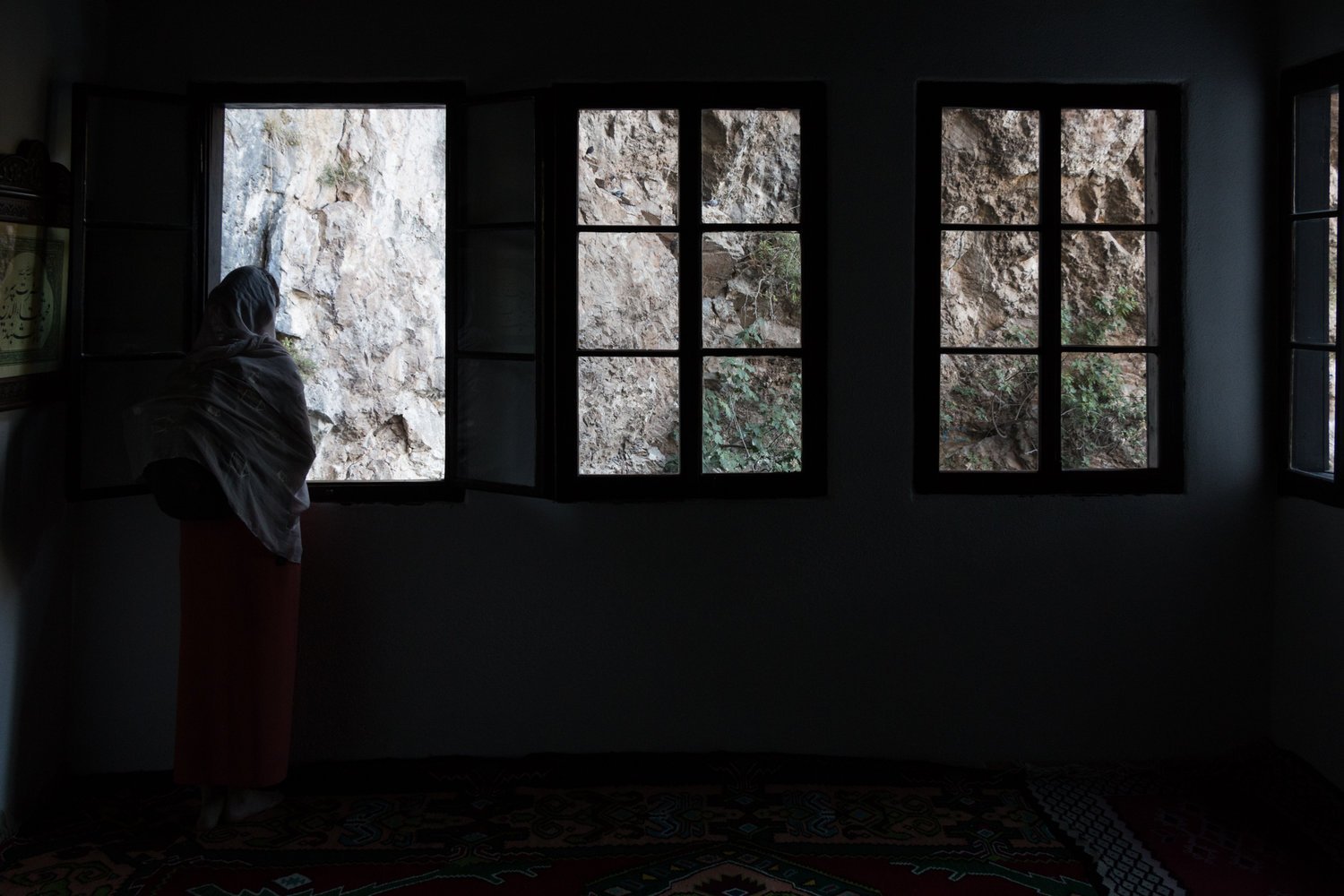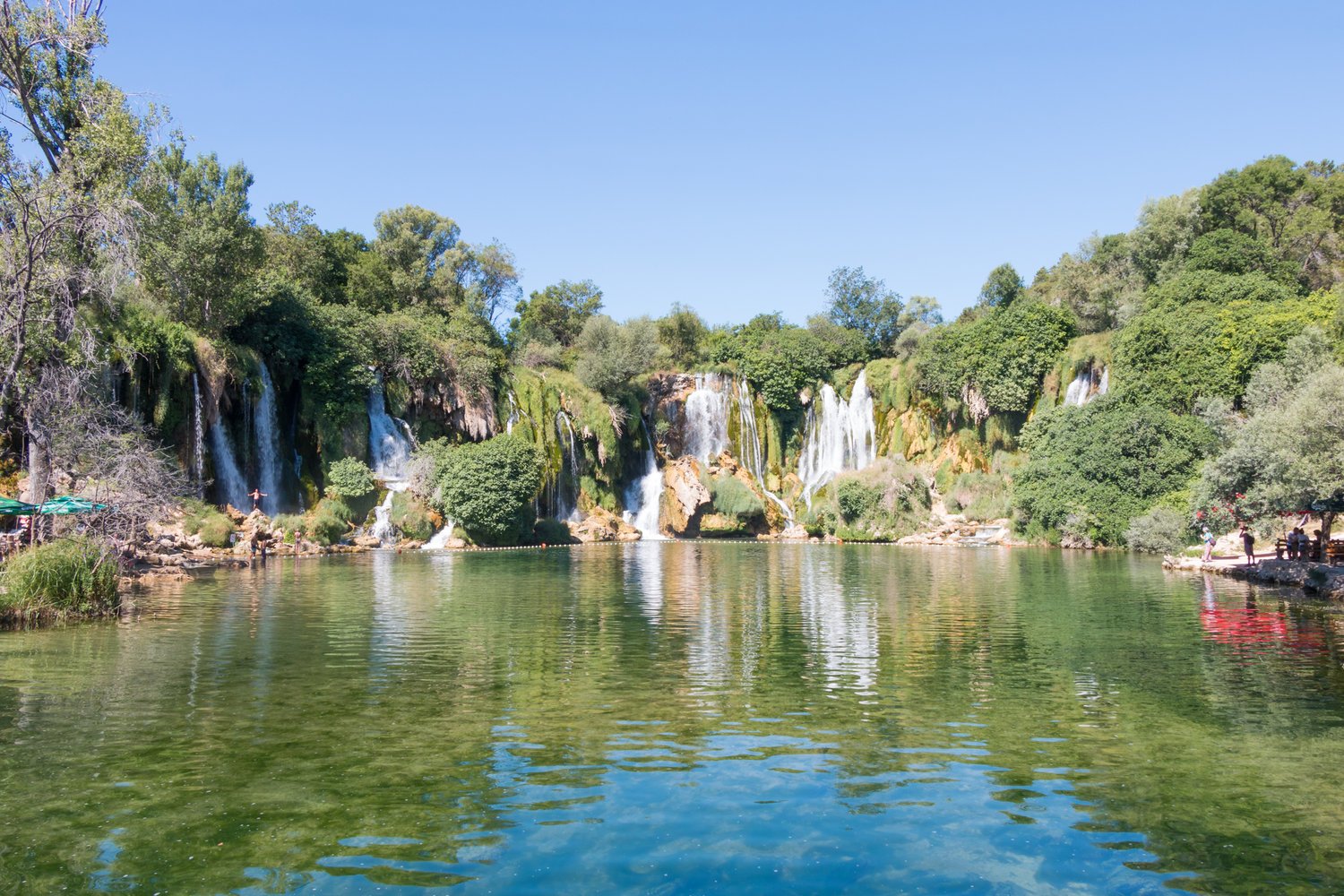Sarajevo & Mostar, Bosnia
In preparation for our first trip to Croatia in 2015, we did some reading about the fall of Yugoslavia, and our interest in the causes of its breakup and the ensuing wars has only grown since then. Bosnia saw the worst of the conflict, from a years-long siege of its capital and the destruction of Mostar's beautiful Old Bridge to the Serb-Croat collusion to partition Bosnia for themselves and genocide at Srebrenica. The Western Balkans are not perfect today, and divisions in Bosnia linger, but what we find beautiful is that a country that in our lifetime was consumed by a brutal war has emerged full of life. We needed to see it for ourselves, so along with our third visit to Croatia in as many years, we knew our first ever two-week trip had to include Bosnia.
Sarajevo
Our Airbnb, in the thick of Baščaršija, Sarajevo’s old Ottoman center, was on the top floor of one of the tallest buildings in the area and offered great views of the city. Sarajevo sprawls along the floor of a valley, hugged tight by rolling mountains on all sides. Naturally our visit started with a stroll around the old center. Within five minutes of stepping outside our door we had a run-in with a pickpocket who we noticed was following us, even after abruptly changing direction three times. It’s important to be vigilant in any city, but especially when in one of the region’s poorest countries. Not to be deterred, we wandered around until we came to the Miljacka River and the unsuspecting Latin Bridge, the site of the assassination of Archduke Franz Ferdinand which sparked World War I.
For a different perspective, we walked up to the Yellow Fortress at the east end of the old town. On our way we walked through a cemetery, one of the many reminders of the wars in the early 90s. If you spend any time in the parts of the former Yugoslavia that saw the most fighting, you’ll quickly notice that cemeteries are littered with gravestones displaying dates of death between 1992 and 1995. These are especially frequent sights in Bosnia. It’s easy to get caught up in the past and feel a sense of dread in a place like this, but the views of raw natural beauty from the fortress shed light on the more optimistic side of things as well.
Another shining example of reconstruction and resilience is the City Hall, built in 1894 and converted in 1949 to the National Bosnian Library. In August 1992, during the siege of the city, Bosnian Serb forces shelled the building, destroying it and most of the works contained therein. It reopened only a few years ago after much painstaking reconstruction. The main hall is simply stunning; words will not do it justice, so we’ll let the pictures speak for us!
Before the wars, Sarajevo was one of the most multi-ethnic cities in Europe. For many years it was one of the few places in the world where Catholics, Orthodox Christians, Muslims, and Jews lived not only in peace and harmony, but also in close association—many marriages were mixed, and places of worship were more or less next door to each other. Today the city is primarily Muslim, marked by the minarets that pepper the skyline and the calls to prayer that fill the air five times per day. We visited a mosque for the first time in our lives in Sarajevo—two in fact! Gazi Husrev-beg Mosque is located in the center of the old town and its grounds are a respite from the busy streets outside. Emperor's Mosque, just south of the river, has a pristine and peaceful courtyard. We were lucky enough to meet the muezzin—responsible for singing the call to prayer. He was excited to share his thoughts on Islam, and his passion for his faith and condemnation of those who use Islam to justify hatred and violence really personalized the religion for us. In a world where one in four people pray to Allah, it’s critical that we seek out the side of Islam not often shared in the West on TV or in the news. (Head to Ashkenazi Synagogue to learn more about the city’s small Jewish community.)
Though it is indeed helpful to see Bosnia for what it is today, we were also here to learn lessons from the wars, and there are few places better to do that than Gallery 11/07/95. The gallery shows photos that chronicle the aftermath of the genocide at Srebrenica, where Bosnian Serbs systematically murdered more than 8,000 Muslims. The museum is one of the most well done we’ve ever visited; it’s a good size, is logically laid out, and has an informative and high-tech audio guide system. We recommend setting aside an hour or two of decompression time after your visit.
Further to the point of learning, we booked slots on the “Complete War Tour” by Ervin at Toorico Tours. Ervin lived through part of the wars as a child and now runs a variety of independent tours; they are the most well-reviewed tours in and around Sarajevo, and for good reason! We set off in a van, first stopping up in the hills above Sarajevo where Serb forces lobbed shells and positioned snipers during the city's 4-year siege. The roads in the hills are lined with landmine warning signs—over 2% of the country’s territory is still mined. A stop at the Tunnel of Hope, where Bosnians dug an underground tunnel from the besieged city to the UN-controlled airport to allow humanitarian aid in and people out, was refreshing.
We stopped for lunch (local specialty burek from Panera) on the podium by the ski jump from the 1984 Winter Olympics before setting off further into the hills to the dilapidated bobsled track, now covered in graffiti. A hotel on Mount Igman was constructed in the lead up to the Winter Olympics. After the breakout of the war in 1991, the luxury hotel was used by the Bosnian Muslim forces in their defense of the city against the encroaching Bosnian Serbs. When they ceded their position, they set the hotel ablaze so that it wouldn't fall into the hands of the Bosnian Serbs. These days you can freely walk through the ruins, which stand in stark contrast to the surrounding forests and mountains. Throughout the whole tour, Ervin shared not only his personal story from the war, but also his thoughts on today’s political climate and modern Bosnian culture and life. The country struggles with crushing bureaucracy and corruption, and many young people are leaving, but tourism is increasingly quickly and many locals hope that Bosnia can someday join the EU.
One thing about modern Bosnia is certain: the food is amazing. It’s a perfect mix of Turkish (from the Ottoman days) and central European (from the Austro-Hungarian days) with a unique Balkan flair. One of the “must-dos” is ćevapi at Željo, which is consistently ranked one of the best in the city. Delicious dinners were had at Dveri (mućkalica, grilled chicken, homemade bread), a cozy restaurant right by our Airbnb; Nova Bentbaša (grilled meat platter, sesame chicken), which offers riverside dining; and To Be (chocolate chili steak, spaghetti with tomato sauce, apple cake), a small local gem. And for dessert you can’t go wrong with the wide assortment of baklava from the aptly named Baklava Shop Sarajevo!
Our three days in Sarajevo were eye-opening and a rollercoaster of emotions. Next, we will cover our drive through some of the most beautiful and untouched mountain scenery in Europe, three days in Mostar, and day trips aplenty!
After three nights in Sarajevo, we picked up a rental car and hit the road! Our final destination was Mostar, but we had a few stops to make on the way. First was Vrelo Bosne, a nature reserve just 20 minutes outside of Sarajevo at the source of the River Bosna, which gives the country Bosnia its name. A series of paths and bridges guide you through the park; the peacefulness was a nice break from the hustle and bustle of the city. It wasn’t long after getting back in the car that we were on the scenic road toward Mostar (the M17). It’s hard to describe the drive; it was one of the best we’ve ever done, driving below craggy peaks, winding through lush valleys, passing charming villages, all the while tracing the impossibly blue-green Neretva River. There’s a scenic train ride that follows a similar path, but driving allowed us to stop and take in the views. We stopped for lunch at Vidikovac in Konjic which offered views of the river and the town’s Old Stone Bridge.
Mostar
Eventually, we arrived in Mostar and checked into the incredible Muslibegovic House, which doubles as a museum (and rightfully so—it’s beautiful!). The city of Mostar is split in two halves by the Neretva River. The eastern half is predominantly Muslim and the western half is predominantly Catholic. This part of the country, known historically as Herzegovina, is home to much of the country’s Catholic (and ethnically Croat) population. The city’s two halves are dramatically linked by Mostar’s iconic 16th-century Ottoman bridge, Stari Most ("Old Bridge"). The bridge stood as a symbol of the city's blended diversity (before the war it had the highest number of mixed marriages in the country) for over 400 years until it was destroyed in November 1993 by Croat forces. After the war the bridge was painstakingly reconstructed, using pieces of the original that had fallen into the river below, and reopened in 2004. You can get a good look at the destruction and reconstruction of the bridge in the war photo exhibition in one of the buildings on the bridge. These days the bridge is most famous for the local divers who take the 65-foot (20-meter) plunge into the frigid Neretva to much fanfare—but only after they’ve collected enough money from the hordes of spectating tourists!
Kujundžiluk, east of the river, is the main tourist street and hosts a number of shops, of varying quality and authenticity. Art Studio Pandur recommended to us by our hotel, is one of the quality shops where we picked up a tin dish and bracelet. We visited two mosques nearby: Karađozbegova (simple and clean interior) and Koski Mehmed-Pašina (the best views of Mostar from the minaret—not to be missed!). On the west side of the river, we appreciated little Kriva Ćuprija, one of the smaller stone bridges scattered throughout the city.
There is a handful of restaurants in Mostar that appear on almost every list of recommended dinner spots in the city. We sampled the menus at three of them: Šadrvan (ćevapi and chicken garden salad), Hindin Han (ćevapi and chicken skewers), and Tima-Irma (ćevapi, chicken salad, baklava). We recommend them all, especially if you eat late enough for the day-trippers to have left so that you may enjoy the tranquil ambiance.
From Mostar, we took advantage of our car and ventured out on some day trips. On our first full day, we visited Blagaj Tekija (20 minutes from Mostar), a 16th-century Dervish house built into the cliffside at the Vrelo Bune river spring. The surreal setting is matched in the interior of the house, with its distinctive architecture and design.
On our second full day, we visited Kravice Falls (1 hour from Mostar), a series of lakes and waterfalls reminiscent of Croatia’s famous Plitvice Lakes. The difference at Kravice (other than the smaller scale) is that you can swim! In addition to swimming, we also climbed around the waterfalls and took the short hike to Mala Kravice (“Little Kravice,” which was underwhelming).
On our way back from Kravice we stopped at Počitelj (30 minutes from Mostar), a small town with not much to do other than stroll the cobblestoned lanes and climb up to the fortress for great views over the surrounding area. That day was the hottest yet (105°F / 40°C), so we cooled off with fresh pomegranate juice from a small stand at the base of the town.
After dealing with that kind of heat for our three nights in and around Mostar, we knew it was time to cool off. Lucky for us we were about to board a bus bound for the Adriatic for the second half of our two-week trip. Stay tuned for stories from our time in Split and Hvar in what has become one of our favorite countries in Europe—Croatia!












































